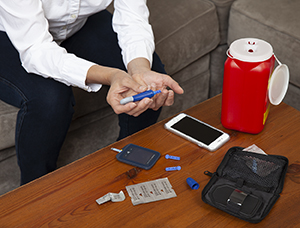How to Check Your Blood Sugar
Keeping track of how much sugar (glucose) is in your blood is an important part of self-care when you have diabetes. This is also called self-monitoring of blood glucose (SMBG). To make sure your glucose and insulin are in balance, check your blood sugar as instructed by your healthcare provider. You may need to check your blood glucose levels at certain times every day.
Another way to keep track of your blood glucose is using a continuous glucose monitor (CGM). This small device uses tiny sensors attached to your skin. It is always recording your glucose levels in real time. You still may need to do finger sticks from time to time. This is to be sure the GCM is accurate. Think about teaching a close family member or friend how to test and record your blood sugar. This extra support may come in handy if you are ill.
What you need
To check your blood sugar, make sure you have:
-
A small pricking needle (lancing device)
-
Test strips
-
A glucose meter with test strips that match it
-
A way to keep track of your readings (smartphone, glucose meter, notebook, chart, or logbook)
Using a blood glucose meter
You can check your blood sugar at home, at work, and anywhere else. Your diabetes team will help you choose a blood glucose meter. A meter measures the amount of glucose in a tiny drop of blood. You’ll use a device called a lancet to draw a drop of blood. Put the strip in the meter first. Then touch the test strip to the drop of blood. The meter then gives you a number (reading). This is your blood sugar level.

Aim for your target range
Your blood sugar should be in your target range—not too high and not too low. A target range is where your blood sugar level is healthiest. Staying in this range as much as possible will help lower your risk for health problems (complications). Your diabetes team will help you figure out the best target range for you. That range depends on many things. They include:
-
Your age
-
Other health problems you may have
-
How well your diabetes is controlled
-
How long you've had diabetes
In general, target ranges are:
-
Control of blood glucose (A1C test, also called hemoglobin A1C). The goal for most people with diabetes is 7.0% or lower. The A1C is a blood test at the lab. It measures your blood sugar levels over the past 3 months. It is an important tool in managing your diabetes.
-
Before a meal (preprandial glucose). The target range is between 80 and 130 mg/dL.
-
1 to 2 hours after a meal (postprandial glucose). The range is less than 180 mg/dL.
-
At bedtime. The range should generally be between 90 and 150 mg/dL.
Track your readings
Use a smartphone, glucose meter, notebook, chart, or logbook to keep track of your readings. Record the date, time, and your blood sugar level numbers. This helps you see patterns. For instance, if you have high blood sugar after eating certain foods. Take your log information along when you see your healthcare provider. Also keep a list of any questions for your provider. They may also have an electronic medical record that offers helpful tools and tracking options.
Your blood glucose levels are key. They help your provider decide if they need to make changes to your management plan. To check your blood sugar, follow the steps below.
Step 1. Get ready
-
Wash your hands for at least 20 seconds with soap and clean, running water.
-
Follow all of the instructions that came with your glucose meter. Check that your test strips were designed to be used with your meter and that they haven't expired.
Step 2. Draw a drop of blood
-
Prick the side of your finger at the tip with the lancet. Squeeze gently until you get a drop of blood. Squeezing too hard can cause an inaccurate reading.
-
Put the lancet in a special sharps container. Ask your healthcare team where you can buy one or what you can use to throw away any sharps.
-
If you can't get enough blood, hold your hand at your side and gently shake it. If this is a common problem for you, ask your provider if you can use other parts of your body to get the blood from.
Step 3. Place the drop on a strip
-
Wait for the meter to show a message or symbol that it's time to test.
-
Touch the test strip to the drop of blood.
-
Follow the instructions included with the meter.
Step 4. Read and record your results
-
Wait for your meter to show the result.
-
If you see an error message, recheck using a fresh strip and a fresh drop of blood. Also recheck if the glucose numbers aren't what you expect—too low without symptoms, or too high for no reason.
-
Record the results using the method you've chosen. Bring your record to your next appointment.